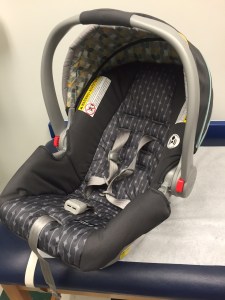All babies and children will ride in a car at some point in their lives. Many will take their first ride on the way home from the hospital following delivery. It is important for parents to know how to safely transport these little ones from their first ride until they are drivers themselves.
Let’s look at statistics. The National Highway Transportation and Safety Administration reports over 32,000 traffic fatalities in 2013. About 4% of those were children. Fatalities in children have decreased over the years with the largest reduction in the 8-14 year old age range. This is mostly due to improved restraints for children and increase use of seatbelts. Below is a guide to safely using these restraints and riding in the car for each age group.
Infants and toddlers. What type of car seat will you need?
Choosing a seat is a big undertaking. Many families like the convenience of the rear facing only seat that is also used as a carrier and can be easily removed from a car base and placed onto a stroller. This is great for little babies but will eventually get heavy as your child grows. Furthermore, it will not carry a child all the way up until age 2. If you choose a rear facing only seat remember that you will likely need a convertible seat within the first 1-2 years. The convertible seat can be installed either rear facing or forward facing and frequently will hold children longer as they get bigger. Most will take a child in the rear facing position up to 35 pounds.
Once you have picked a rear facing seat, it’s time to install it and to do it correctly. You can get help from your local fire or police station as many have certified car seat installers. Rear facing seats should be installed so that the baby is at a 45 degree angle. Most carriers have angle indicators on the side to let you know if the seat is in the correct position. It should be installed tightly with very little mobility. Cars now come equipped with a LATCH(Lower Anchor Tethers for Children) system that serves to anchor a car seat. If you visit Healthy Children you will find videos and diagrams that can help you with installation.
The next step is to make sure your baby is in the seat correctly. A recent study from Oregon Health and Science University reported that 93% of babies were riding incorrectly in their seats. The majority of those had straps that were too loose, followed by babies who had the retainer clip placed too low. It is vital that the straps are right up against your baby with no slack. Put blankets over the straps as opposed to under them. Make sure the retainer clip is on the chest right at nipple line. Also, avoid using after market additions like head rests.
Children over 2 years. When can they switch to a forward facing seat?
This category may include children under 2 who have outgrown their rear facing car seats.
For children who are ready to move to forward facing car seats, look for one that will accommodate your child up to 60+ pounds. Install the seat using the LATCH system and be sure it is tight without any mobility. Don’t forget to attach the top tether if available. Use the 5 point harness system and again have the straps up against your child with the chest buckle right at nipple line. Follow the manufacturer’s recommendation for when it is time to move the straps to the next slot.
Moving to the booster seat, when is the right time?
These days it is easy to find car seats that fit older kids. Many will take kids up to 80 pounds! Some even transition into booster seats. My recommendation is to leave young school aged kids in these seats for as long as they fit (based on manufacture height and weight limits). Once your child has outgrown the height and weight limit of the seat they can move into a booster seat that is used with the car’s seat belt. These seats are not tethered to the car and come either with or without a high back. These seats should be used for any child under age 8 and up to 12 years who is out of their car seat but below 4 feet 9 inches.This is because most cars are equipped with seat belts intended for people 4’9″ or taller. Under 4’9″ the seat belt is more likely to sit across the neck as opposed to down on the collar-bone. This can increase the likelihood of fatal injury in a crash.
When can children move to a seat belt without the booster seat?
Most kids 12 and over are big enough, and mature enough, to sit in the seat with just the seat belt. Just be sure the shoulder strap rests in the middle of the shoulder and the lap belt is low on the hips. Furthermore, these kids are safest in the back seat and not in the front. The AAP recommends keeping kids in the back seat until at least 13 years old.
Keep in mind that it is best to obtain a new care seat as older seats may have been recalled, in a crash or expired. Car seats expire after 5 years, so check your seat.
For more information visit:
- safercar.gov
- cert.safekids.org to find a car seat specialist
- healthychildren.org
- nhtsa.gov for recall information



